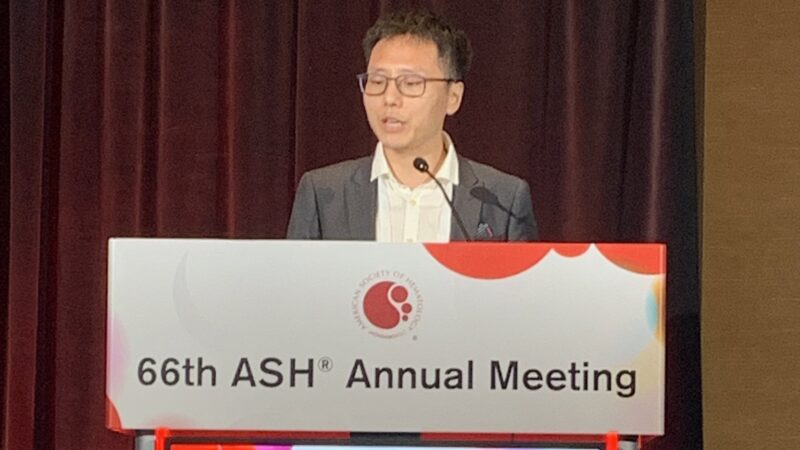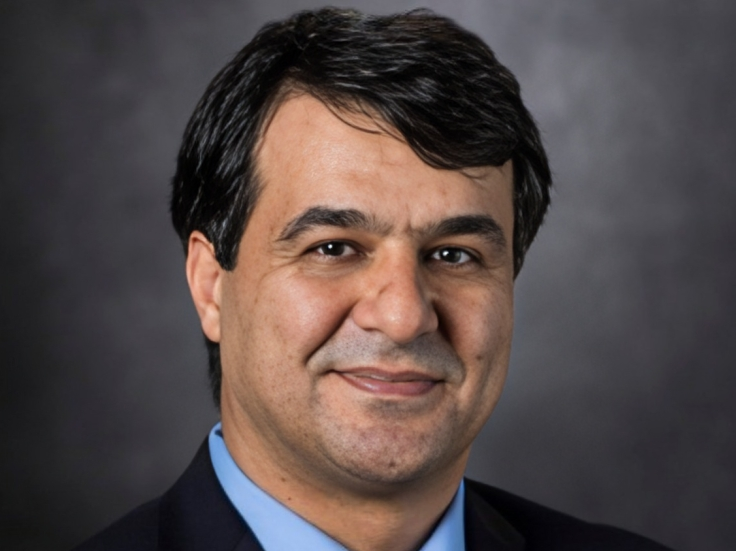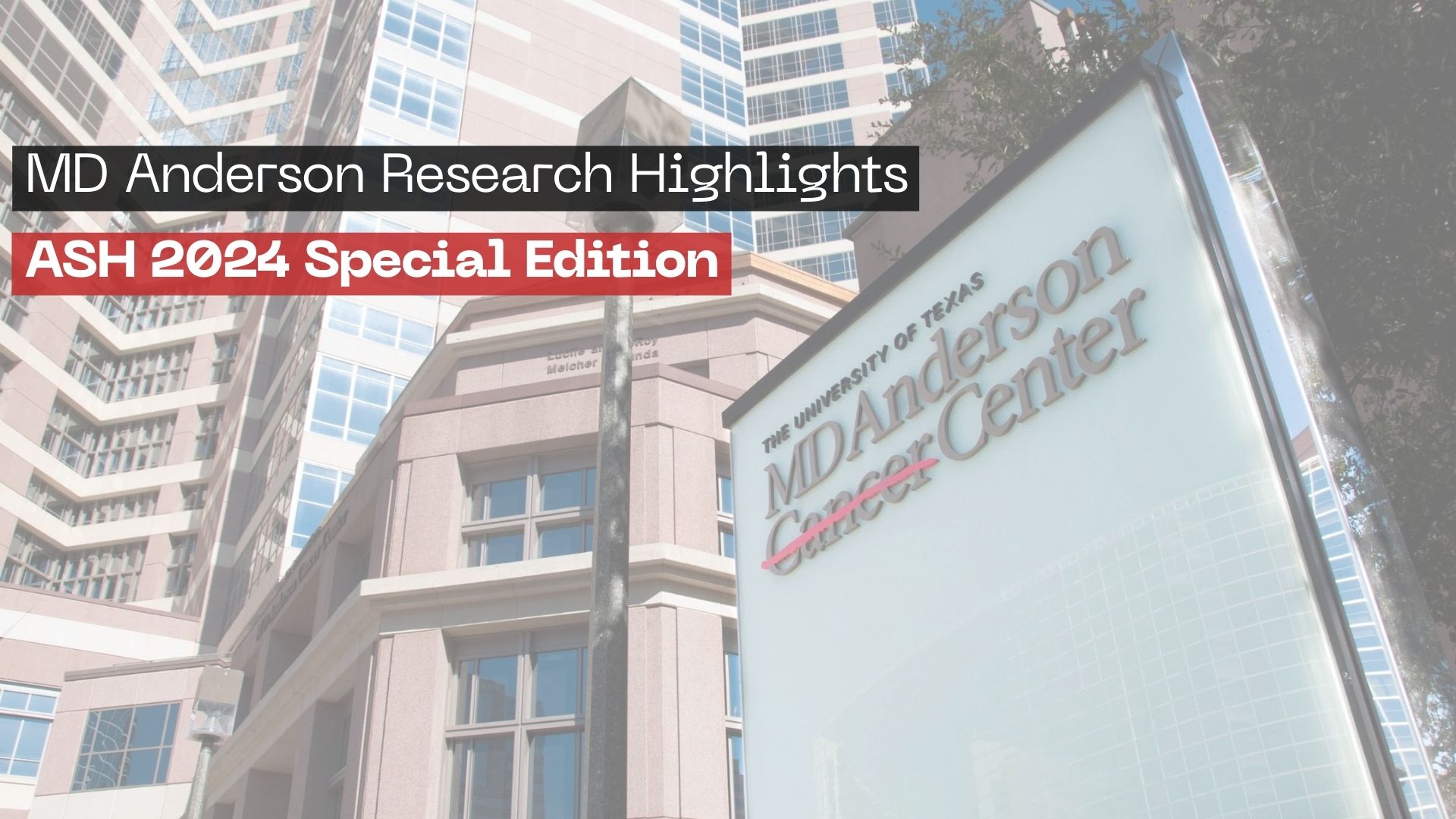Featuring novel treatments and research insights for MDS, leukemia, and lymphoma, encouraging long-term trial data, and potential targets for overcoming anemia
The University of Texas MD Anderson Cancer Center’s Research Highlights showcases the latest breakthroughs in cancer care, research and prevention. These advances are made possible through seamless collaboration between MD Anderson’s world-leading clinicians and scientists, bringing discoveries from the lab to the clinic and back.
This special edition features upcoming oral presentations by MD Anderson researchers at the 66th American Society of Hematology (ASH) Annual Meeting and Exposition, providing new insights and advances in hematological malignancies and diseases.
Novel drug overcomes anemia in preclinical models of MDS-RS and sickle cell disease (Abstract 153)
Patients with blood disorders such as myelodysplastic syndromes with ringed sideroblasts (MDS-RS) and sickle cell disease have a stress response mechanism that includes the heme-regulated inhibitor (HRI) pathway. This pathway can be activated when heme, a fundamental part of hemoglobin, is low. In particular, patients with MDS-RS may have a mutation that affects red blood cell production and function, causing anemia and requiring blood transfusions.
Research led by Simona Colla and Vera Adema used a virtual screening platform to design and create more than 200 diverse HRI inhibitors, including two notably potent and selective inhibitors. In lab models of MDS-RS and sickle cell disease, these compounds improved red blood cell development, reduced anemia and increased hemoglobin production.
These findings show the therapeutic potential of targeting the HRI pathway to overcome anemia, reducing the need for blood transfusions in patients with MDS-RS and sickle cell disease. Adema presented the findings on Dec. 7th.

Triplet therapy improves survival in older adults with FLT3-mutated AML (Abstract 220)
Small studies have indicated that combining a FLT3 inhibitor with a hypomethylating agent (HMA) and venetoclax may improve outcomes for older patients with newly diagnosed FLT3-mutated acute myeloid leukemia (AML), a high-risk subtype of the disease.
In a clinical trial led by Nicholas Short, this triplet therapy achieved promising responses, with 92% of patients reaching complete or incomplete remission. The median overall survival (mOS) was 28.1 months, with a three-year survival rate of 46%, indicating encouraging long-term results. Patients with RAS pathway mutations had poorer survival rates, and new RAS mutations emerged in 20% of relapses.
Overall, the triplet regimen demonstrated superior outcomes compared to the standard of care in older adults with FLT3-mutated AML, where the historical mOS was only 10 months. The study highlights this treatment as a viable option for improving survival in this high-risk AML population. Short presented updated findings on Dec 7th.

Luspatercept provides long-lasting benefits in lower-risk MDS (Abstract 350)
The COMMANDS trial demonstrated that treatment with luspatercept significantly reduced the need for regular blood transfusions in most patients with lower-risk myelodysplastic syndrome (MDS). In a long-term analysis of the trial, led by Guillermo Garcia-Manero, researchers reported that 44.5% of patients receiving luspatercept experienced at least one year of transfusion independence, compared to 27.6% of those treated with epoetin alfa.
Notably, 30.2% of patients treated with luspatercept maintained transfusion independence for over 18 months. These benefits were consistent across subgroups, including patients with ring sideroblast-negative status and low baseline erythropoietin levels. Progression to high-risk MDS or acute myeloid leukemia remained rare and comparable between treatment groups.
These results position luspatercept as a durable and effective option for epoetin alfa-naive, transfusion-dependent patients with lower-risk MDS. Garcia-Manero presented the findings on Dec 7th.

Lengthening treatment timeline and adding novel agents may benefit patients with high-risk leukemia (Abstract 506)
Patients with high-risk acute myeloid leukemia (AML) and myelodysplastic syndrome (MDS) generally have poor outcomes, even after stem cell transplantation (SCT). While busulfan-based treatments are effective as conditioning therapy for SCT, patients can still relapse, highlighting a need for more effective strategies. Preclinical studies suggest combining busulfan and fludarabine with additional drugs – cladribine, venetoclax, and thiotepa – can destroy leukemia cells.
In a Phase II trial led by Uday Popat, researchers investigated the effectiveness of this combination and extended its administration from a few days to three weeks. The trial, which included 49 patients with high-risk AML or MDS, met its primary endpoint and revealed an encouraging two-year progression-free survival rate of 61% in very high-risk patients. The findings suggest this protocol merits further investigation. Popat presented the findings on Dec. 8th.

Single-cell multi-omic profiling identifies factors associated with BCMA-targeted treatment responses (Abstract 767)
Therapies targeting B cell maturation antigen (BCMA) have changed the landscape for patients with relapsed or refractory myeloma, but further insights are needed to better sequence treatments and predict responses. In a study led by Minghao Dang and Robert Orlowski, researchers performed single-cell RNA and T/B cell receptor sequencing on 89 samples from 54 patients, characterizing the cellular and molecular properties of the tumor microenvironment.
They found distinct profiles associated with responses to BCMA-targeted therapies. For example, responders had more monocytes and conventional dendritic cells present, while non-responders showed evidence of upregulated interferon-stimulated genes.
These observations provide valuable insights into mechanisms of responsiveness and could help better predict patient outcomes. The study also highlighted potential targets to overcome the immunosuppressive microenvironment in patients who did not respond to BCMA-targeted treatments. Dang presented the findings on Dec. 9th.

Specific FLT3 mutations without NPM1 co–mutations linked to lower survival rates in AML (Abstract 841)
FLT3 tyrosine kinase domain (FLT3-TKD) mutations occur in 8 to 10% of patients with newly diagnosed acute myeloid leukemia (AML), but the outcomes and prognosis of these patients is unclear. To characterize potential risk factors, researchers led by Sankalp Arora and Naval Daver, compared patients with FLT3-TKD mutated AML with and without co-occurring NPM1 mutations.
Patients without co-occurring NPM1 mutations had poorer outcomes, with a median overall survival (mOS) of 13.8 months on intensive chemotherapy and 4.4 months with low-intensity therapy. Patients with co-occurring NPM1 mutations had improved outcomes; the mOS with intensive chemotherapy had not yet been reached (three-year OS 71%), and the mOS was 22.9 months with low-intensity therapy.
Allogeneic stem cell transplantation improved mOS for FLT3-TKD mutated AML without NPM1 co-mutation but did not demonstrate a clear survival benefit when NPM1 co-mutations were present. Arora presented the results on Dec 9th.

Axi-cel CAR T cell therapy delivers durable five-year outcomes in lymphoma (Abstract 864)
The ZUMA-5 trial demonstrated that axi-cel, a chimeric antigen receptor (CAR) T cell therapy, provided durable responses after two years in patients with relapsed/refractory follicular lymphoma (FL) and marginal zone lymphoma (MZL) who received at least two prior treatments.
In long-term follow-up on the Phase II trial, led by Sattva Neelapu, investigators found the therapy continued to show durable effectiveness after more than five years. The median progression-free survival (PFS) was 62.2 months, and 50% of patients reached a median PFS of 60 months. Among patients achieving complete responses, median PFS had not yet been reached at the time of data cutoff, and 58% of patients remained in remission.
Overall survival at 60 months was 69%, and more than half of the patients required no additional therapy. No new safety concerns emerged, and only one late progression event occurred in FL after four years. Neelapu presented the results on Dec 9th.

New preclinical model for therapy-related myeloid neoplasms reveals potential targets (Abstract 882)
Patients treated with certain chemotherapies can sometimes develop a life-threatening complication known as therapy-related myeloid neoplasms (t-MNs). While the causes for this are not completely understood, TP53 mutations are seen in 25 to 40% of cases.
Therefore, researchers led by Rasoul Pourebrahim, developed a novel TP53-mutant model that consistently replicates the biology of t-MNs. This model addresses a critical gap in understanding the progression from clonal expansion to malignant transformation in hematopoietic stem cells harboring TP53 mutations.
Key findings include recurrent chromosomal deletions, mutations in RAS pathway genes, and upregulation of DNA repair and cell cycle regulation pathways. The model provides a critical tool for exploring the mechanisms driving t-MNs, providing insights into potential targets to treat or prevent the disease. Pourebrahim presented the findings on Dec. 9th.

Vibecotamab shows promise in high-risk leukemia and myeloid diseases (Abstract 1007)
Many patients with leukemia and other blood cancers involving blast cells – abnormal blood stem cells in the bone marrow – relapse after initial responses to standard therapies. Previous studies have identified CD123 as a marker on these blast cells, leading researchers Daniel Nguyen, Nicholas Short, and colleagues to evaluate vibecotamab, a novel CD123-targeting immunotherapy.
The Phase II study treated 37 patients with low-blast myeloid diseases from two groups: one with myelodysplastic syndrome (MDS) or chronic myelomonocytic leukemia (CMML), and the other with measurable residual disease (MRD)-positive acute myeloid leukemia (AML).
In the MDS/CMML group, 68% of patients responded to vibecotamab. Among patients with MRD-positive AML, 28% achieved MRD negativity, with some responses ongoing for over two years. All responses were observed after the first cycle of therapy. These findings highlight the effectiveness of vibecotamab and show its potential for combination treatments in this setting. Nguyen presented the results on Dec. 9th.
Other posts featuring MD Anderson Cancer Center:
Obe-cel CAR T Therapy Achieves High Response Rates in R/R B-cell ALL: FELIX Trial Results
MD Anderson study reveals hidden chromosomal abnormalities in healthy breast cells
MD Anderson Research Highlights: SITC 2024 Special Edition
